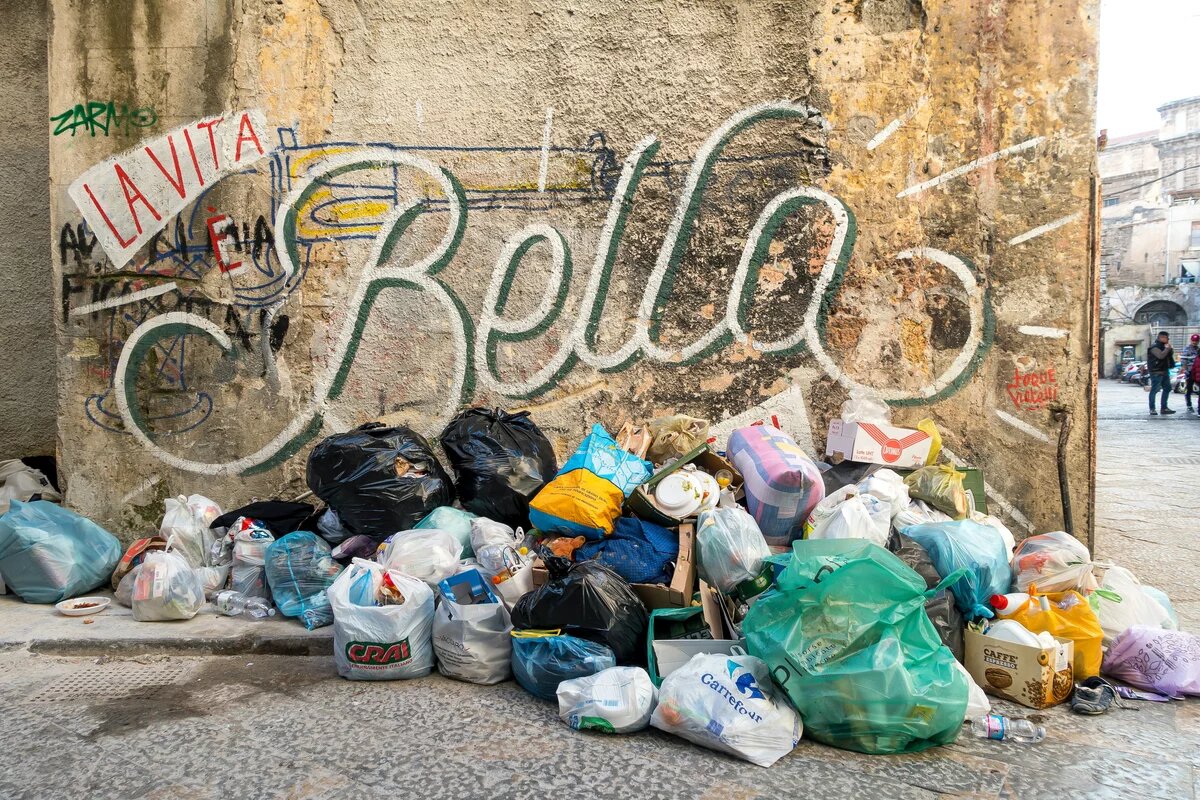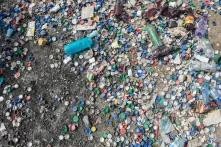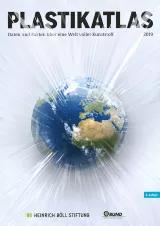Plastic is a material that used to be a symbol of progress and modernity. Now it represents an industry that subordinates everything to profit, even if the world is ruined in the process.

In 2014 British marine scientists discovered a previously unknown crustacean in the deep sea. In the Mariana Trench of the Pacific Ocean, at depths of between 6,000 and 7,000 metres, they caught four amphipods that ranged from one to five centimetres in length. In the body of one of the creatures they identified the plastic polyethylene terephthalate (PET), which is used in the manufacture of drinks bottles, plastic films and textile fibres. They christened the new species Eurythenes plasticus. The name was a sign of protest: plastic had arrived in one of the most inaccessible places on Earth.
Plastic particles are being found on South Sea islands, in the Arctic ice, on the banks of the Rhine and in the fields of European farmers. Now they have turned up in the Mariana Trench. Plastic, a material that once stood as a symbol of progress, has become a nightmare for humans and nature. Around 40 percent of all plastic products are discarded after less than a month. The average plastic water bottle is used for six months; a mixing bowl lasts for perhaps three years. In Germany, 2.8 billion disposable cups are used and thrown away each year. That equates to roughly 320,000 takeaway hot drinks cups every hour.
During the coronavirus crisis, plastic has become even more of a problem: the amount of plastic waste generated by private households has risen by ten percent since March 2020. Worldwide, 465 million tonnes of plastic were manufactured in 2019 and output is still rising. Even before the coronavirus struck, the plastics industry was planning to increase production by 30 to 40 percent in the coming years. The historically low oil price and the increased demand for plastic products as countries battle the pandemic threaten to exacerbate this trend. And plastic not only poses a waste problem but also has a catastrophic impact on the climate. According to the International Energy Agency, plastic will account for half the growth in the global demand for oil by 2050. The Center for International Environmental Law has calculated that, unless the plastics industry changes course, plastics will consume between 10 and 13 percent of the global carbon budget by 2050. Awareness of the problems of plastic is growing steadily. But if we are serious about wanting to remove this substance from nature and from our bodies, we must not deceive ourselves.
Myth 1: Less plastic is being produced
Back in the 1950s, people used plastic as carefully as glass and silk. It was regarded as special, modern and progressive – a material that was used economically and that had major advantages in many areas such as medicine. Then at the end of the ‘60s, the throwaway era began. This was a turning point everywhere: all sorts of disposable products emerged and plastic bottles replaced glass ones. Since 2000 there has been a veritable explosion in plastic production. Of all the plastic that has ever been produced – more than ten billion tonnes (as at 2019) – more than half has been made in the past 20 years. In 2019, Coca-Cola’s annual production of disposable bottles amounted to 167,000 plastic bottles per minute, or 88 billion bottles per year. In Germany, as elsewhere, the quantity of packaging waste is growing: at around 227 kilos per person per year it is at least 20 percent higher than the European average. Plastics make up one-third of these 227 kilos.
Myth 2: Plastic was banned a long time ago
Most governments (127 out of 196) have started to regulate the use of plastic, for example by banning cotton buds, disposable cutlery, drinking straws or carrier bags. That is a good move. Sixty-one countries – including Bangladesh, Kenya, Rwanda, Costa Rica and Italy – and also some cities such as San Francisco have now actually banned the manufacture and import of such products. However, a ban often means only that items such as plastic carrier bags cannot be given away free, or the ban may only cover particularly thin plastic bags.
Myth 3: It is not our waste that is causing the problem
For far too long, people in this country regarded plastic waste as a problem that existed on the other side of the world. But the plastic floating in the Atlantic comes in part from us. Germany is in fact one of the world’s biggest exporters of plastic waste, it exported more than one million tonnes in 2019. Since China significantly restricted imports of plastic waste at the start of 2018, our waste has been shipped mainly to Malaysia and other countries in South-East Asia. Some of these countries are witnessing a surge in protests against this German waste – and they are sending it back.
Myth 4: It’s all recycled
Germany likes to see itself as the world recycling champion. Many people in this country assume that the plastic that they dispose of in the right container is fully recycled and returns to the market as new plastic. That is incorrect. In 2016, according to the official recycling statistics produced by the Federal Environment Agency (UBA), the material recycling rate was just under 47 percent. However, this figure relates to the quantity delivered to recycling companies and not to the actually recycled output. In Germany, less than 16 percent of what is euphemistically termed “post-consumer waste” – the total quantity of plastic products that are discarded after use – is turned into recyclate (recycled plastic). And only eight percent of this recyclate – a tiny amount overall – is comparable to new plastic. The remainder is of lower quality and accounts for less than three percent of the plastic products produced in Germany, since manufacturers prefer to use new plastic. It is because of the low price of used plastic and the high costs of sorting and processing it that most of the plastic waste that arises in Europe is shipped overseas. Talk of a circular economy is almost entirely unjustified. For a circular economy to exist, there would have to be compulsory minimum standards that define the recyclability of packaging. At present it is only with considerable difficulty that the majority of materials can be separated from each other. Too many compound materials hinder sorting and subsequent recycling. We need to incentivise product design that incorporates the concept and the objective of recycling and the circular economy from the outset. The aim should be to create products that are durable, repairable, recyclable and free of toxic substances – these should be the standards for contemporary product design.
Myth 5: It is up to us
Ninety-nine percent of plastic is made from fossil resources – in other words, from oil and gas. As long as petrochemical plastic manufacturers continue to systematically expand their capacity in order to produce more plastic, our search for ways out of the plastic crisis should start with them. Producers in the chemical, food and packaging industries are skilfully evading their responsibility when they say that consumers are free to decide what they buy and how they dispose of things. The sector finances hundreds of global, national and regional lobbying associations and pursues an elaborate marketing campaign in order to exert influence on policy-makers and manipulate society’s perceptions. In its communications it emphasises the fact that plastic is versatile, durable, light and hygienic. Manufacturers pass the buck to the disposal companies by claiming that the plastic crisis is primarily a waste crisis.
We are told that a plastic-free world is a pipe dream. And yet for most of its existence the world has managed without plastic.
The five biggest plastic companies that dominate the global market are Exxon Mobil, Chevron Philips, ENI, BASF and Ineos. These corporations have production facilities for the international market in more than 200 countries. They have managed to exempt themselves from levies on fossil fuels in England and from taxes in the USA. A particularly influential company when it comes to lobbying is Ineos, the biggest plastic producer in Europe. It is investing billions in order to crank up plastic production in Europe using cheap fracking gas from the USA. Three billion euros is to be spent on a facility at the port of Antwerp that will convert propane and ethane into propylene and ethylene, which are important feedstocks in the production of plastic. This is one of the largest petrochemical investments in Europe in the last 20 years. Fortunately, the initial protests against it are becoming louder. In many developing countries, industry giants such as Unilever and Procter & Gamble are capturing market share by offering mini-portions of shampoo, detergent or ketchup in plastic sachets. This represents a shocking imbalance between packaging and contents. If there is no local waste disposal system, the packaging of these mini-portions ends up in the environment. The plastic giants ignore this.
We don’t have a plastic problem – we have a plastic crisis. How are we going to get out of it?
What is vital is the prevention of waste so that it doesn’t arise in the first place. A useful step would be a prevention goal for all packaging waste in the form of an annual upper limit of 90 kilos of waste per person from 2030 onwards. Another step would be a rapid ban on the manufacture and marketing of single-use plastic products. The Single-Use Plastics Directive approved by the European Council in 2019 can only be a start: the number of disposable products it covers is small. In March 2020 the European Commission submitted a Circular Economy Action Plan with the aim of reducing waste and lengthening product life.
What is lacking are concrete targets and a timetable. We should be aiming for zero waste wherever possible. European waste legislation has defined this as the ultimate goal. “Non-packaged” is the slogan and is already the practice in hundreds of newly created Unverpackt shops in Germany. They all demonstrate that consumption without plastic is possible if we search purposefully and actively for viable alternatives. Microplastic-free cosmetics and toiletries must be introduced as quickly as possible, together with a legal ban on microplastics as a primary raw material.
At every stage of the life cycle of plastics the rule should be that everyone who produces or sells plastic should be liable for damage in accordance with the polluter pays principle and should be held responsible. The extensive environmental, health and clean-up costs must at long last be reflected in the price. This can be achieved via economic incentives, taxes on gas and oil for the petrochemical industry, or licence fees and levies. Plenty of calls and ideas on this front are already on the table.
Policy-makers must therefore use all possible means to raise awareness of the issue and to impose legal requirements so that a world without plastic pollution becomes possible. A key aspect of this is that measures must start at the very point where plastic arises – that is, with oil and gas producers and the petrochemical industry.
Of course it is a good thing if more and more people shop for plastic-free and packaging-free items, but the emphasis must be on making producers responsible for supplying plastic-free products. Ensuring that less plastic comes onto the market and that more plastic is recycled is their responsibility. In short, it is only when the principle of circularity works that a world without plastic, an ocean without plastic waste and rivers without micro particles can be more than an attractive vision.
This article is translated from German and appeared first in the magazine Zeit.Wissen. Updated 23 February, 2021.

